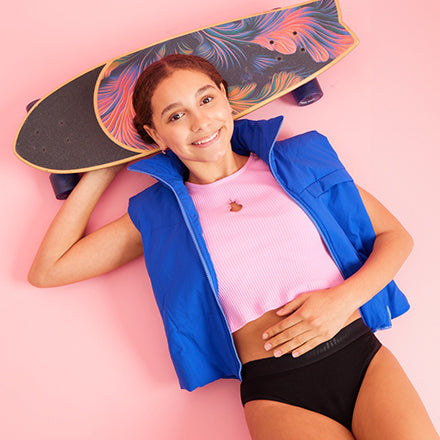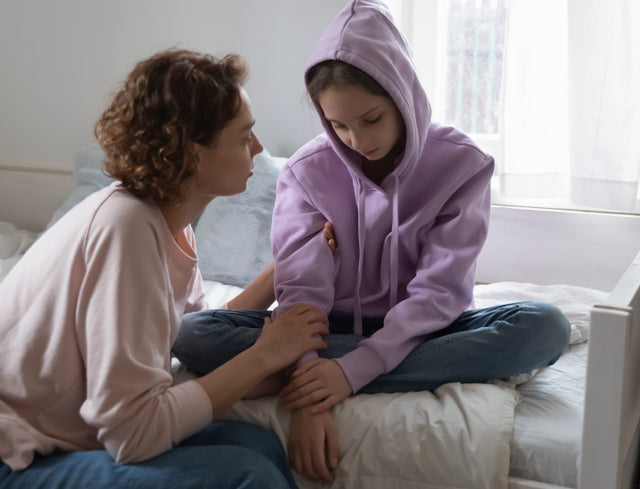Puberty pointers with Dr Jana Pittman: the 5 stages and when puberty ends
Puberty doesn’t come knocking at a specific age – it varies for everyone. As a guideline, female puberty changes occur between the ages of 8 and 13.Males tend to hit puberty a bit later, between the ages of 9 and 14.
Your child may start a bit earlier or later than these ranges.
When do females start puberty?
Dr Jana: “We were very open about my body, but it helped that he was my personal coach. I can imagine in a team environment, it might be a little harder. In this case, hopefully, you can tell your mates if you need a change that day.The more we normalise it, the more likely that one day a coach will say, ‘Right, does anyone need a change today due to your period?’ at the start of a session.
In terms of uniforms, as a Modibodi ambassador, I am happy that the PUMA x Modibodi period activewear range means we now have a solution that means the colour of our sports uniform is less problematic. But if it still bothers you, have a voice. Be brave and compete anyway but let your coach know you feel uncomfortable.”
What causes early puberty in girls?
In most cases, pinpointing the reason for early puberty is tricky. Potential factors may be genetics, nutrition and environmental influences. Rarely, a health condition or injury affecting the brain, sex glands, adrenal glands, thyroid or hormones may be the cause.If you suspect your child is entering puberty early and you’re worried, contact your doctor. They may prescribe medicine to hit pause on the process.
What are girls’ puberty stages?
The Tanner stages of puberty, named after child development expert Professor James M Tanner, describe the physical changes that happen during puberty – and can help you gauge your child’s progress through this transformative period.Every person has a unique puberty timetable though. So keep in mind that the following is just a guide.
Stage 1: prepubertal
Puberty starts when the brain gives the body a heads-up that changes are coming. It sends hormones to the pituitary gland, prompting it to make more hormones that will control other glands in the body.
This stage is all about internal changes rather than physical ones. It usually starts after females turn 8 and after males turn 9 or 10.
Stage 2: physical changes begin
After the ages of 9 and 11 for females and 11 for males, the new hormones start telling parts of the body that it’s time for change.
In females, small breast ‘buds’ form under the nipple, and the darker skin around the nipple expands. The uterus grows a bit and the beginnings of pubic hair appear on the lips of the vulva.
In males, the testicles and the skin around them (the scrotum) start getting bigger and pubic hair begins growing on the base of the penis.
Stage 3: physical changes speed up
Physical changes tend to progress in this stage. Expect a growth spurt!
After age 12, females’ breast buds continue to grow, pubic hair gets thicker and curlier, and armpit hair appears. The hips and thighs tend to gain fat, and some kids get acne on their face and back.
After age 13, males will notice that their penis gets longer and testicles continue to grow. They start having wet dreams (ejaculation during the night) and their muscles get larger. Their voices start to change and may ‘crack’, jumping between higher and lower pitches.
Males might also grow some breast tissue under the nipples – this usually disappears over the following two years.
Stage 4: puberty is in full swing
Many changes happen in this stage, which usually starts after females turn 13 and males turn 14.
Females’ buds get fuller and become breasts, their pubic hair thickens further and menstruation begins. This is when Modibodi’s Teen Range takes centre stage – supporting teens through their first periods in superior comfort (and style). They’re even great for before menstruation begins, as they look and feel just like regular underwear.
Meanwhile, males’ testicles, penis and scrotum continue to grow and the scrotum darkens in colour. Armpit hair appears, the voice deepens permanently and acne might develop.
Stage 5: puberty ends
When puberty ends at around the age of 15, your teen will have reached full physical maturity.
Females’ breasts usually settle into their adult size and shape, and periods start to regulate. The reproductive organs and genitals will fully develop, while the hips, thighs and buttocks fill out in shape.
Males’ penis, testicles and scrotum reach adult size and facial hair starts growing.
All teens start reaching full adult height in this stage. Also, their pubic hair usually fills out and spreads to the inner thighs.
When does puberty end?
Most people reach full growth by age 18, with females often finishing puberty between the ages of 14 and 16. But remember, everyone is different – it’s very normal for the body to continue changing into adulthood.The more you know...
Getting familiar with the transformation from kid to fully-fledged adult can help you and your child navigate puberty with less uncertainty and more confidence. They may want to keep their feelings to themself, but it’s a good idea to keep the lines of communication open in case they want some advice on what to expect.If puberty is causing distress or concern, chat to your doctor.
Keen to keep reading? Explore our blog.









